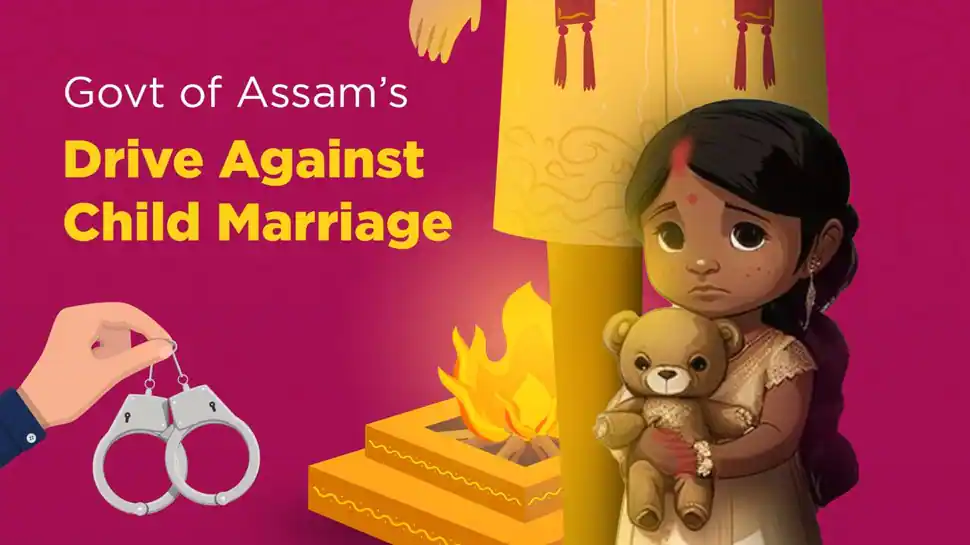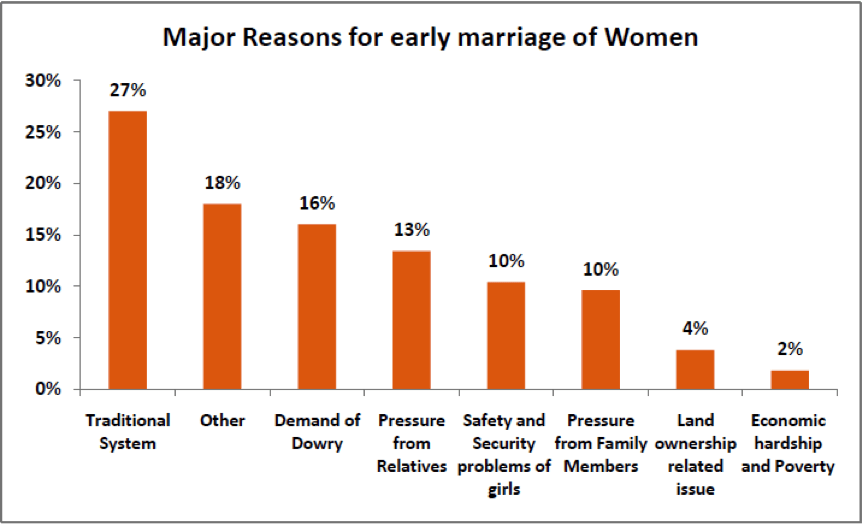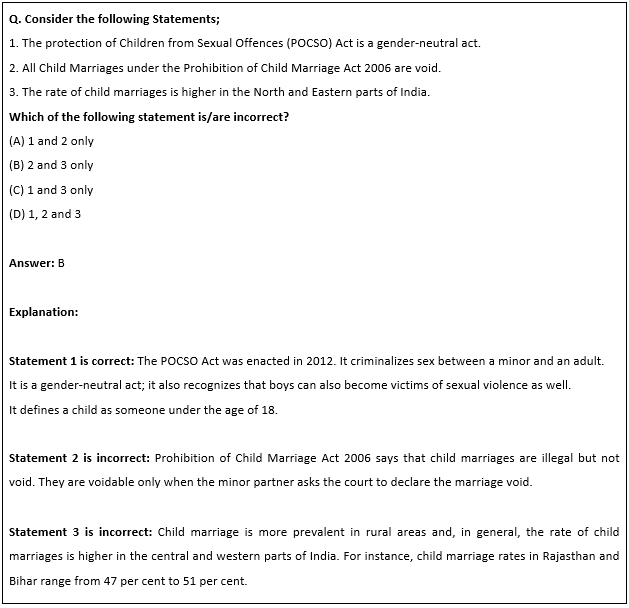Description

Copyright infringement not intended
In News:
- Over 2000 men were arrested in Assam during a state-wide crackdown on child marriages.
- The arrested men were charged under the strict provisions of the POCSO Act and the Prohibition of Child Marriage Act.
Details:
- The Chief Minister of Assam recently said that the police will arrest people who participated in child marriage in the last 7 years.
- Men are arrested under which law?
- Men who married girls below 14 years of age are booked under the Protection of Children From Sexual Offences (POSCO) Act.
- Men who married girls between 14 and 18 years are booked under the Prohibition of Child Marriage Act.
.jpeg)
Protection of Children from Sexual Offences (POCSO) Act:
- The POCSO Act was enacted in 2012. It criminalises sex between a minor and an adult.
- It is a gender-neutral act; it also recognizes that boys can also become victims of sexual violence as well.
- It defines a child as someone under the age of 18.
- The law does not recognize a minor’s consent as valid.
- It also specifically lays down stringent punishment for exposing children to or using them to create child sexual abuse material.
- The Act penalizes storage of pornographic material for commercial purposes with a punishment of up to 3 years, a fine, or both.
- The law lays down the procedures for reporting sexual crimes against children.
- It places the burden of proof on the accused, following ‘guilty until proven innocent’ unlike the IPC.
- Sexual assault under POCSO is a non-bailable, cognizable offence. This means that the police can arrest without a warrant.
- Section 19 of the POCSO Act imposes a “mandatory reporting obligation” which requires every person who suspects or has knowledge of a sexual offence being committed against a child must report it to the police or the Special Juvenile Police Unit. Failure to do so will result in imprisonment, a fine, or both.
- The mandatory reporting obligations also require doctors to report cases where minor girls seek medical services during pregnancies.
Prohibition of Child Marriage Act 2006:
- The act says that child marriages are illegal but not void.
- They are voidable only when the minor partner asks the court to declare the marriage void.
- The Act prescribes 18 years as the minimum marriageable age for women, while for men it is 21 years.
- The Act punishes child marriage with imprisonment which may extend to 2 years or with a fine which may extend to Rs 1 lakh or both.
- The punishment also extends to anyone who performs or conducts any child marriage.
The debate over the Muslim legal age of marriage under personal law:
- Under Muslim personal laws, the marriage of a bride who has attained puberty is legal.
- Puberty is presumed on completed at the age of 15 years.
- The age gap difference provision between Muslim personal law and special legislation prohibiting child marriages or the sexual activity of minors classifying it as a criminal offence.
Recently the Supreme Court decided to take the issue to ensure a common rule of law as various High Courts ruled differently on this issue.
- Several High Courts highlighted the fact that many families under POCSO allege rape even when the minor girl has decided to marry of her own choice.
- In October 2022, the Karnataka High Court quashed a POCSO case against a Muslim man who was arrested when his pregnant wife, aged 17 years visited a doctor (The hospital made mandatory disclosures under the law).
- In January 2013, the Karnataka High Court ruled that the Prohibition of Child Marriage Act will have an overriding effect on the provisions of Muslim personal laws.
- Recently, the Punjab and Haryana High Court stated that a Muslim girl can legally marry after attaining puberty, after this, the National Commission for Protection of Child Rights (NCPCR) filed an appeal in the Supreme court challenging the High court verdict because personal laws can’t override special penal statutes.

Challenges with the Present Acts:
- Lack of complaint: Most of the victims experience terrific social humiliation and feelings of shame and guilt when they report that they are sexually assaulted. It either delays or leaves out a no of victims.
- Lack of awareness: Parents or guardians often do not have the knowledge to safeguard their children either by educating the children about sexual abuse or by being watchful to prevent abuse on their children.
- Poor rate of conviction: POSCO act is plagued by the low rate of conviction. It was 14% in 2014 and 18% in 2018.
- Many states have not complied with the provisions of the act as they have not established special children's courts.
- Ineffective training of public prosecutors has often led to the acquittal of the perpetrator.
- The Karnataka High Court said the effect of such criminal prosecution of a minor girl or boy is causing severe distress to all concerned, including the families.
- Sometimes, dissatisfied parents file a case to foil a relationship between two adolescents.
- Misuses by parents to decide who their daughters or sons want to marry.
- The government introduced the Prohibition of Child Marriage (Amendment) Bill, 2021 which seeks to increase the minimum age of marriage for women to 21 years.
- Social activists feel that increasing the marriage age may force vulnerable women to remain under the control of the family and social pressures.
Age of consent in India:
- India's age of consent for sex is set at 18 years under the Criminal Law (Amendment) Act, 2013, regardless of gender.
- In 1892, the marital rape and subsequent death of a 10-year-old girl, Phulmoni Dasi, caused the age of consent to be raised from 10 to 12 years.
- In 1949, it was raised to 16 years after agitation from women's groups about the adverse effect of early pregnancy.
- The Criminal Law (Amendment) Act, of 2013 increased the legally permissible age for sexual consent from 16 to 18.
- Although the Criminal Law (Amendment) Act, of 2013 initially sought to lower the age to 16, it was set at 18 due to political pressure from conservative parties.
- Section 375 of the Act: A man is said to commit "rape" if he has sexual relations with a girl less than 18 years of age with or without her consent.
- POSCO Act, 2012 disallows any such sexual relationships between people under 18 years of age and puts such crimes within marriages as an aggravated offence.
- An exception under the act; According to Section 375, Sexual Intercourse by a man with his wife, the wife not being under 15 years of age, is not rape.
Child Marriage in India:
- As per Census 2011, over 12 million child marriages were reported in the country.
- Child Marriage is defined as a marriage of a girl or boy before the age of minimum legal age (18 years).
- According to the data released by National Family Health Survey-5
- In India, 8 States have a higher prevalence of child marriage than the national average; West Bengal, Bihar and Tripura top the list with more than 40% of women aged 20-24 years married below 18.
- States with a large population of tribal poor have a higher prevalence of child marriage. In Jharkhand, 32.2% of women in the age bracket 20-24 got married before 18 years.
- Infant mortality stood at 37.9%
- 8% of women in the 15-19 years age bracket are anaemic.
- Assam has a high prevalence of child marriage (31.8% in 2019-20).
- States with high literacy levels and better health and social indices have performed much better; In Kerala, women who got married before the age of 18 years stood at 6.3% in 2019-20.
- The reason behind Child Marriage
- It is a widely practised social custom.
- Poverty and Illiteracy of a Child's parents.
- Social and Economic Condition of the family including the Cultural values of the family and the Surrounding Society.
- Lack of awareness about the harmful effects of lack of Schooling.
- Political Patronage: Due to Social acceptance politicians find it difficult to oppose the practice of child marriage as it may mean losing votes and Support.
- Child marriage is also widely reported to be used to traffic girls from poor and tribal families for either the Sex trade or as cheap labour.
- It is more prevalent in rural areas.
- Rates of Child marriage are highest in the Central and Western parts of India and lower in the eastern and southern parts of India.
- Result of Child Marriage;
- It Restricts access to education and better opportunities in the future.
- It limits the freedom of decision and promotes socio-economic and gender inequality.
- It is associated with multiple health risks, limited Knowledge and access to, and use of, Contraception and reproductive health services and information.

Concern:
- Child marriage violates children’s rights, and also results in more infant and maternal deaths. Children born to adolescent mothers have a greater possibility of seeing stunted growth as they have low weight at birth. According to NFHS-5, the prevalence of child stunting is 35.5% in 2019-21.
- About a quarter of 20-24-year-old women are married before the age of 18 years, despite that being the minimum age of marriage since 1978.
- The limited success of the current law raises the question of whether an increase in the minimum age would have any significant impact on reducing the incidence of child marriage
- According to NFHS-5 (2019-21), the prevalence of underage marriages remains high, with 23% of women between 20 and 24 years of age married before the age of 18. At the same time, the detection of such marriages remains low, with only 785 cases registered under the law in 2020.
- This raises the question of whether the increase in the minimum age would have any significant impact on reducing child marriages.
- Increasing the legal age for marriage for women will increase the number of marriages performed underage and render young adults without legal protection.
Steps by Government:
- Indian Parliament enacted several laws including the Prohibition of Child Marriage Act, 2006 and the Protection of Children from Sexual Offences Act, 2012, to protect the human rights of Children.
- Beti Bachao Beti Padhao to address the declining Child Sex Ratio.
- PM Matru Vandana Yojana (PMMVY) Providing Cash incentives for improved health and nutrition to pregnant and nursing mothers.
- Scheme for Adolescent Girls aims at girls in the age group 11-18, to empower and improve their social status through nutrition, life skills, home skills and vocational training
- Pradhan Mantri Mahila Shakti Kendra scheme promotes community participation through the involvement of Student Volunteers for the empowerment of rural women
- National Crèche Scheme to provide daycare facilities to children of the age group of 6 months to 6 years of working women who are employed.
- Rashtriya Mahila Kosh (RMK) to provide micro-credit to poor women for various livelihood support and income-generating activities at concessional terms
- Swadhar Greh provides relief and rehabilitation to destitute women and women in distress.
- Ujjawala is a Comprehensive Scheme for the prevention of trafficking and rescue, rehabilitation, reintegration and repatriation of victims of trafficking for commercial sexual exploitation.
- Working Women Hostels for ensuring safe accommodation for women working away from their place of residence.
- One-Stop Centre (OSC) and Women Helpline (WH) are being implemented to facilitate access to an integrated range of services including medical aid, police assistance, legal aid/ case management, psychosocial counselling and temporary support services to women affected by violence.
- Emergency Response Support System set up under Nirbhaya Fund.
- Mahila Police Volunteers, to report the incidences of violence against women.
- The dowry Prohibition Act, of 1961, Penalizes Giving & taking.
- SABLA Scheme, Providing life Skills and Supplementary nutrition to out-of Schoolgirls.
- The national database on Sexual offenders includes the name, addresses, photographs and fingerprint details of those Convicted in Sexual assault Cases.
- National Policy for Women, 2016
- Addresses women's issues throughout life-Cycle, issues from education, health, economic participation, decision making, violence, Creation of an enabling environment etc.
- In 2020, the Union government has set up a task force under Ms Jaya Jaitly, it suggested increasing the age of marriage for females to 21.
- The Prohibition of Child Marriage (Amendment) Bill, 2021 seeks to increase the minimum age of marriage for females to 21 years.
Way Forward:
- The issue of increasing the age of marriage for women must be supported with other measures that help delay underage marriages such as access to education and improving women’s safety.
- The practice of child marriages is largely due to the overall social customs, tradition, illiteracy, poverty, low status of women in society, and lack of awareness. These issues cannot be tackled by legislative interventions alone.
- More awareness needs to be generated to make more children come forward for their child abuse.
- Proper training of police, forensic staff and public prosecutors need to be put in place for enhancement o the conviction rate.
- The introduction of sex education in schools and educating the children about good touch and bad touch is significant.
- In 2008-09 Parliamentary committee report mentions the introduction of sex education, but it never materialized. It has to be implemented.
- There is a need for improved access to education, skill training and employment opportunities, safety for women and strengthening maternal health services to reduce maternal and infant mortality rates.
- Need to adopt a comprehensive approach to curb the factors closely related to child marriage, including poverty eradication, better education and public infrastructure facilities for children and raising social awareness on health, nutrition, regressive social norms and inequalities.



https://indianexpress.com/article/explained/explained-law/assam-crackdown-on-child-marriage-what-does-the-law-say-8430003/






.jpeg)











